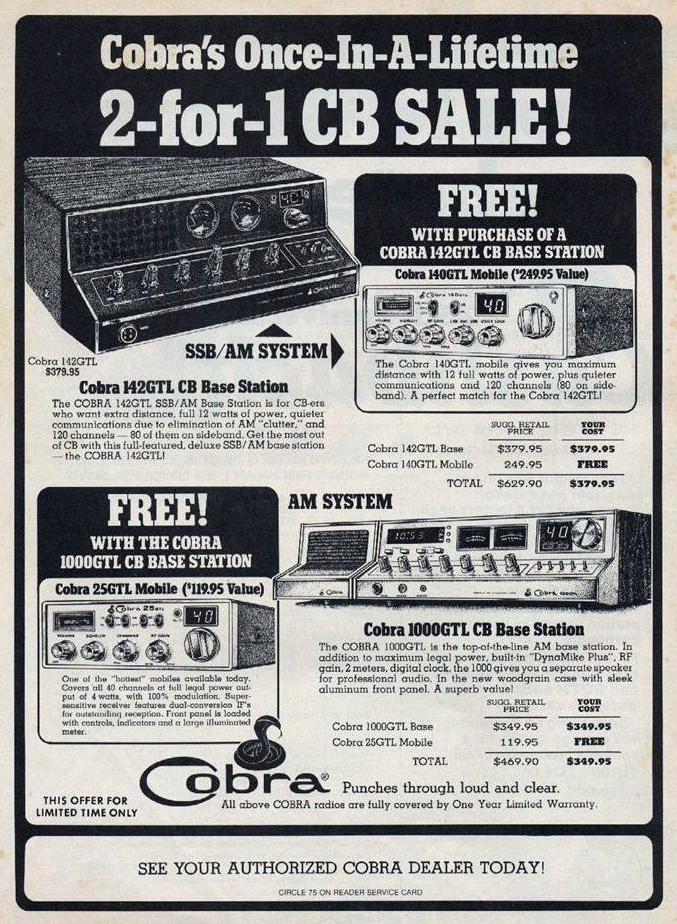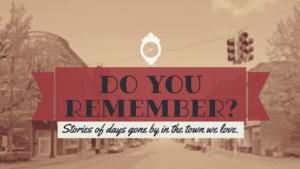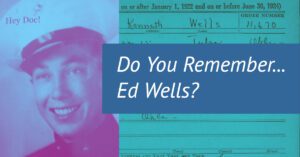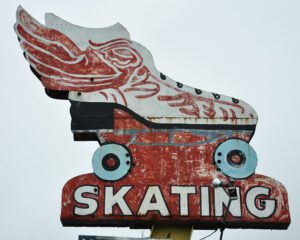Before cell phones and the internet, the CB (Citizen’s Band) radio was the most effective way to engage in group discussions, locate the nearest gas station, or report a traffic accident. CB radio service was first utilized by small businesses, truck drivers, and radio hobbyists. As advancements took place in electronics, the radios became smaller and more affordable. By the 1970s, CB radio was sweeping the nation as the latest “fad.”
I purchased my first mobile CB radio in 1976. I bought the “top of the line” Cobra. This radio cost me wholesale almost $200 (about $900 in today’s dollars). I paid $55 for the red, white, and blue, bi-centennial edition of an Antenna Specialists antenna. I mounted it on the trunk of my 1974 Subaru and it looked like a 3-foot rhinoceros horn on that little car.
Technically, one was supposed to have a license and have a radio call sign. The FCC never really enforced this and ended licensing in 1983. I never obtained a license.

Today, people on Facebook and chat rooms have noms de plume known as screen names. Back in the CB radio days, one had a “handle.” My handle was “Circuit Jockey.” My friend Daryl Howard installed a CB radio in his 1972 Javelin AMX and went by “White Stag.” Daryl was an avid scuba diver and White Stag was a brand of scuba equipment. I had a custom license plate made for the front of my car to display my CB handle.
Many people operated what is known as a “base station.” This is a radio that has higher power output and is in a fixed location, much like fire and police dispatchers’ radios. Many people who were elderly or home-bound found a new way to communicate with friends, neighbors, and truckers.
CB radios originally had 23 channels, then later expanded to 40 channels. In this part of the United States, channel 19 was to be allocated for use by truckers. Nationally, channel 9 was for emergencies.
I utilized the CB radio when we traveled, I would monitor the trucker’s channel, hoping to hear a “Smokey report.” A smokey report was a quaint colloquialism for a report on the local speed traps. This was important because the energy crisis in 1973 resulted in the speed limit being reduced to 55 MPH to save gasoline. I always exceeded the speed limit when traveling long distances.
I also used the CB radio a few times to report an accident, and in one case, report a possible carjacker. In 1977, my wife and I were helping our friends Don and Donna Barefoot move back from Enid. I was driving my company van and I came upon an old Chevy pickup by the side of the road on the Cimarron Turnpike. There was a “Bridge Out” sign next to it and a fellow was waving his arms. I used the CB to contact my friends and tell them about this since they were a few miles behind us. My friend Don said there was no bridge ahead and told me not to stop. I sped by and reported this on channel 9 and the trucker’s channel.
CB radio enthusiasts and truckers used a “ten-code” similar to law enforcement. Some examples are 10-1, receiving poorly; 10-2, receiving well; 10-4, OK, message received; 10-6, stand by; 10-7, out of service (leaving air); 10-9, repeat message; 10-21, call by telephone; 10-32, radio check;10-36, correct time is —-; 10-42, traffic accident at—-; 10-62, unable to copy, (use phone); 10-73, speed trap at—-;10-100, need to go the bathroom; and 10-200, police needed at —.
Truckers developed their own lexicon, which other CB radios users adopted. Some examples are: Alligator, blown tire in road; Ankle Biter, small child; Baby Bear, rookie cop; Back door, someone behind you; Back Door Closed, rear of convoy covered from police; Backside, return trip; Bear, police officer; Barefoot, using an unmodified radio; Bear in the Air, police helicopter; Blew My Doors Off, passed with great speed; County Mounty, sheriff; Cash Register, toll booth; Diesel Cop, DOT (Department of Transportation); Deadhead, drive an empty trailer to get a load elsewhere; DragonFly, a trucker who “drags” up a hill and “flies” down; Evel Knievel, motorcycle cop; Four-Wheeler, car; Greasy Side Up, a car with its wheels in the air; Hammer Down, move faster; Motion Lotion, diesel fuel; and Taking Pictures, police using radar; Breaker, followed by the channel number, indicates that anyone may acknowledge the transmission, or it may be followed by a person’s handle, thus making a request to talk to that party. Truckers heavily utilized CB radio for traffic updates, police locations, to report accidents, and just to break the boredom of driving for many hours. “Lot Lizards”( prostitutes) utilized CB radio to ply their trade.
Today, in the internet age, you will see people start arguments and “talk trash.” People seem to enjoy venting their anger online. However, back in the days of CB radio, it became more personal. My little brother who went by “Ironsides,” became quite obnoxious on the air using his base station CB radio and incurred the wrath of fellow “CBers.” One night, someone “pinned his coax.” This involves inserting a pin or small nail through the coaxial cable going to the antenna, resulting in expensive damage to the radio.
The CB radio craze inspired such movies as Convoy, Smokey and the Bandit, Breaker! Breaker!, and Citizen’s Band. Cellular phone technology and the internet have all but made CB radios obsolete, however, truckers still use them for traffic reports.










